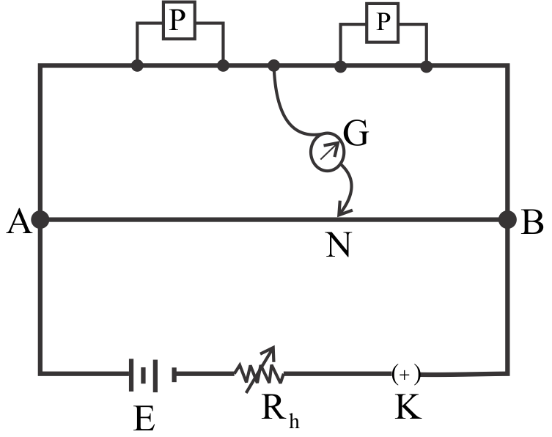
In a meter bridge experiment resistances are connected as shown in figure. Initially resistance $P = 4\Omega $ and the neutral point $N$ is at $60cm$ from $A$. Now an unknown resistance $R$ is connected in series to $P$ and the new position of the neutral point is at $80cm$ from $A$. The value of unknown resistance $R$ is:

(A) $6\Omega $
(B) $7\Omega $
(C) $\dfrac{{33}}{5}\Omega $
(D) $\dfrac{{20}}{3}\Omega $
Answer
225.6k+ views
Hint: Using the formula of a meter bridge, first calculate the value of the resistance $Q$. Then with this value of $Q$ we can determine the value of the unknown resistance $R$ using the same formula.
Formula used
$\dfrac{X}{l} = \dfrac{R}{{100 - l}}$, where $X$ is the known resistance and $R$is the unknown resistance and $l$ is in $cm$.
Complete step by step solution
A meter bridge is an electrical instrument that works on the principle of a Wheatstone bridge. It is used in finding the unknown resistance of a conductor.
It consists of a long wire of $1m$ which is separated into two sections. In the left section we attach the known resistance and in the right section, we attach the unknown resistance. A jockey is present to detect the balance point. The galvanometer indicates the balance point. The balance point is the point on the wire where the galvanometer shows zero deflection.
Let $X$ be the known resistance and $R$ be the unknown resistance.
Then we can write,
$\dfrac{X}{l} = \dfrac{R}{{100 - l}}$
Using this formula we can determine the value of the unknown resistance.
The distance between $A$ and $B$ is $100cm$
It is given that $AN = 60cm$
So, $NB$ would be equal to $\left( {100 - 60} \right)cm = 40cm$
From this diagram we can see that,
$
\dfrac{P}{{AN}} = \dfrac{Q}{{NB}} \\
\Rightarrow \dfrac{4}{{60}} = \dfrac{Q}{{40}} \\
\Rightarrow Q = \dfrac{{16}}{6} \\
\Rightarrow Q = \dfrac{8}{3}\Omega \\
$
Now when another resistance $R$ is connected in series with $P$, $AN$ becomes $80cm$
So, the value of the unknown resistance becomes,
$
\dfrac{{P + R}}{{80}} = \dfrac{Q}{{20}} \\
\Rightarrow \dfrac{{4 + R}}{4} = \dfrac{8}{3} \\
\Rightarrow 12 + 3R = 32 \\
\Rightarrow 3R = 20 \\
\Rightarrow R = \dfrac{{20}}{3}\Omega \\
$
So, the value of the unknown resistance $R$ is $\dfrac{{20}}{3}\Omega $
Therefore, the correct option is D.
Note: The main function of a meter bridge is to find the value of an unknown resistance. Another one of its functions is to compare two different resistances.
Formula used
$\dfrac{X}{l} = \dfrac{R}{{100 - l}}$, where $X$ is the known resistance and $R$is the unknown resistance and $l$ is in $cm$.
Complete step by step solution
A meter bridge is an electrical instrument that works on the principle of a Wheatstone bridge. It is used in finding the unknown resistance of a conductor.
It consists of a long wire of $1m$ which is separated into two sections. In the left section we attach the known resistance and in the right section, we attach the unknown resistance. A jockey is present to detect the balance point. The galvanometer indicates the balance point. The balance point is the point on the wire where the galvanometer shows zero deflection.
Let $X$ be the known resistance and $R$ be the unknown resistance.
Then we can write,
$\dfrac{X}{l} = \dfrac{R}{{100 - l}}$
Using this formula we can determine the value of the unknown resistance.
The distance between $A$ and $B$ is $100cm$
It is given that $AN = 60cm$
So, $NB$ would be equal to $\left( {100 - 60} \right)cm = 40cm$
From this diagram we can see that,
$
\dfrac{P}{{AN}} = \dfrac{Q}{{NB}} \\
\Rightarrow \dfrac{4}{{60}} = \dfrac{Q}{{40}} \\
\Rightarrow Q = \dfrac{{16}}{6} \\
\Rightarrow Q = \dfrac{8}{3}\Omega \\
$
Now when another resistance $R$ is connected in series with $P$, $AN$ becomes $80cm$
So, the value of the unknown resistance becomes,
$
\dfrac{{P + R}}{{80}} = \dfrac{Q}{{20}} \\
\Rightarrow \dfrac{{4 + R}}{4} = \dfrac{8}{3} \\
\Rightarrow 12 + 3R = 32 \\
\Rightarrow 3R = 20 \\
\Rightarrow R = \dfrac{{20}}{3}\Omega \\
$
So, the value of the unknown resistance $R$ is $\dfrac{{20}}{3}\Omega $
Therefore, the correct option is D.
Note: The main function of a meter bridge is to find the value of an unknown resistance. Another one of its functions is to compare two different resistances.
Recently Updated Pages
JEE Main 2025-26 Experimental Skills Mock Test – Free Practice

JEE Main 2025-26: Magnetic Effects of Current & Magnetism Mock Test

JEE Main 2025-26 Atoms and Nuclei Mock Test – Free Practice Online

JEE Main Mock Test 2025-26: Optics Chapter Practice Online

The work done in slowly moving an electron of charge class 12 physics JEE_Main

The value of the resistor RS needed in the DC voltage class 12 physics JEE_Main

Trending doubts
JEE Main 2026: City Intimation Slip and Exam Dates Released, Application Form Closed, Syllabus & Eligibility

JEE Main 2026 Application Login: Direct Link, Registration, Form Fill, and Steps

Understanding the Angle of Deviation in a Prism

Hybridisation in Chemistry – Concept, Types & Applications

How to Convert a Galvanometer into an Ammeter or Voltmeter

Ideal and Non-Ideal Solutions Explained for Class 12 Chemistry

Other Pages
JEE Advanced Marks vs Ranks 2025: Understanding Category-wise Qualifying Marks and Previous Year Cut-offs

Dual Nature of Radiation and Matter Class 12 Physics Chapter 11 CBSE Notes - 2025-26

Understanding Atomic Structure for Beginners

Understanding Average and RMS Value in Electrical Circuits

Degree of Dissociation: Meaning, Formula, Calculation & Uses

Gyroscope Explained: Principles, Working & Real-World Uses




